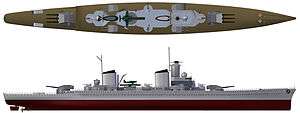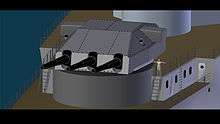D-class cruiser (Germany)
The D-class cruisers were a pair of German cruisers, classified as Panzerschiffe ("armored ships") by the Kriegsmarine (War Navy). The ships were improved versions of the preceding Deutschland-class cruisers, authorized by Adolf Hitler in 1933. They were intended to counter a new French naval construction program. Displacement increased to 20,000 long tons (20,000 t), but Hitler allowed only increases to armor, prohibiting additions to the ships' main battery. Only one of the two ships was laid down, but it was canceled less than five months after the keel was laid. It was determined that the designs should be enlarged to counter the new French Dunkerque-class ships. The construction contracts for both ships were superseded by the Scharnhorst-class battleships.[1]
 CG rendering of the D-class cruiser design | |
| Class overview | |
|---|---|
| Builders: | |
| Operators: | Kriegsmarine |
| Preceded by: | Deutschland class |
| Succeeded by: | P class |
| Built: | 14 February – 5 July 1934 |
| Planned: | 2 |
| Completed: | 0 |
| Cancelled: | 2 |
| General characteristics | |
| Type: | Heavy cruiser |
| Displacement: | 20,000 tons |
| Length: | 230 m (750 ft) |
| Beam: | 25.5 m (84 ft) |
| Draft: | 8.5 m (28 ft) |
| Propulsion: | Turbines, 125,000 shp |
| Speed: | 29 knots (54 km/h; 33 mph) |
| Armament: |
|
| Armor: |
|
Design
The ships were designed as follow-ons to the Deutschland-class cruisers.[1] In 1933, the rise of the Nazi Party brought Adolf Hitler to power in Germany. At the time, he opposed a large-scale naval rearmament program, but decided to allow limited construction to counter French naval expansion. He therefore authorized the Kriegsmarine to build two additional panzerschiffe (armored ships) to supplement the three Deutschlands. He stipulated that displacement be limited to 19,000 long tons (19,000 t) and the primary battery would remain two triple turrets mounting 28 cm (11 in) guns.[2] Admiral Erich Raeder, the commander in chief of the Kriegsmarine, advocated increasing the armor protection for the new panzerschiffe and inquired about the possibility of including a third triple turret. It was determined, however, that a third turret could not be added to the ship and still remain within the 19,000 ton limit prescribed by Hitler.[3]
The ships were designed under the contract names D and E, and designed under the provisional names Ersatz Elsass and Ersatz Hessen as replacements for the old pre-dreadnoughts SMS Elsass and SMS Hessen. The contract for the first ship, D, was awarded on 25 January 1934 to the Kriegsmarinewerft in Wilhelmshaven. The ship's keel was laid on 14 February[1] That month, the Kriegsmarine decided to alter the designs to counter the new Dunkerque-class ships building in France. Displacement was increased to 26,000 long tons (26,000 t) and a third 28 cm triple-turret was added.[2] Construction on D was therefore halted on 5 July, and E was never laid down. The construction contracts were canceled and reallocated for the two battleships of the Scharnhorst class.[1]
Characteristics
The ships were 230 meters (750 ft) long overall, and 225 m (738 ft) at the waterline. The ships would have had a breadth of 25.5 m (84 ft) and a draft of 8.5 m (28 ft). The finalized design displaced 20,000 long tons (20,000 t) at the designed displacement. "D" was to have been fitted with accommodations to serve as a fleet flagship. The ships would have been turbine-powered; the engines were designed to provide 125,000 shaft horsepower (93,000 kW) and a top speed of 29 knots.[1]

The ships would have been similarly equipped to the preceding Deutschland-class ships. The ships would have mounted six of the same 28 cm (11 in)/52 C/28 quick-firing guns in the same triple turret mounts, though eight guns were considered, had there been a quadruple turret available.[1] The guns had an actual bore diameter of 28.3 cm (11.1 in), and fired both armor-piercing and high-explosive shells; both shells weighed 300 kg (661.4 lb). The guns used two sets of propellant charges: a 36.0 kg (79.4 lb) fore charge in a silk bag and a 71.0 kg (156.6 lb) main charge in a brass case. The shells were fired at 910 meters per second (2,986 fps), and at maximum elevation of 40 degrees, a range of 36,475 m (39,890 yards). The guns had a rate of fire of 2.5 rounds per minute.[4] The guns were supplied by a total of 900 shells, for a total of 150 rounds per gun.[1]
The design's secondary battery comprised eight 15 cm (5.9 in)/55 SK C/28 quick-firing guns.[1] The guns fired a 45.3 kg (100 lb) shells at a muzzle velocity of 875 m/s (2,870 ft/s). With a maximum elevation of 40°, the guns could fire out to 23,000 m (75,000 ft).[5] These guns had already been ordered by the time construction of the ships was canceled; their availability influenced the design of the Scharnhorst class,[3] which mounted eight of their twelve 15 cm guns in dual turrets.[6]
The heavy anti-aircraft battery consisted of eight 10.5 cm (4.1 in) SK C/33 guns in twin mountings.[1] The mounts were the Dopp LC/31 type, originally designed for earlier 8.8 cm (3.5 in) SK C/31 guns. The LC/31 mounting was triaxially stabilized and capable of elevating to 80°. This enabled the guns to engage targets up to a ceiling of 12,500 m (41,000 ft). Against surface targets, the guns had a maximum range of 17,700 m (58,100 ft).[7] The guns fired fixed ammunition weighing 15.1 kg (33 lb); the guns could fire HE and HE incendiary rounds, as well as illumination shells.[8] A number of various other anti-aircraft guns were also to be fitted, but the details were not determined before the class was canceled. The ships were also armed with an unknown number of 53.3 cm (21.0 in) torpedo tubes.[1]
The D-class ships used steel manufactured by Krupp for their armor. The ships' upper deck armor was 35 mm (1.4 in) thick. The main armored deck was 70 mm (2.8 in) forward, 80 mm (3.1 in) amidships, and decreased to 70 mm towards the stern. The conning tower was quite heavily armored, with side armor 300 mm (12 in) thick. The main armored belt was 220 mm (8.7 in) thick, and the citadel armor was 50 mm (2.0 in) thick.[1]
Footnotes
- Gröner, p. 63.
- Garzke & Dulin, p. 128.
- Garzke & Dulin, p. 130.
- DiGiulian (28 cm/52).
- Campbell, p. 241.
- Gröner, pp. 31–32.
- Campbell, p. 247.
- Campbell, p. 248.
References
- Campbell, John (1985). Naval Weapons of World War II. London: Conway Maritime Press. ISBN 978-0-87021-459-2.
- DiGiulian, Tony (28 December 2008). "Germany 28 cm/52 (11") SK C/28". NavWeaps.com. Retrieved 1 April 2009.
- Garzke, William H.; Dulin, Robert O. (1985). Battleships: Axis and Neutral Battleships in World War II. Annapolis: Naval Institute Press. ISBN 978-0-87021-101-0.
- Gröner, Erich (1990). German Warships: 1815–1945. Vol. I: Major Surface Vessels. Annapolis: Naval Institute Press. ISBN 978-0-87021-790-6.